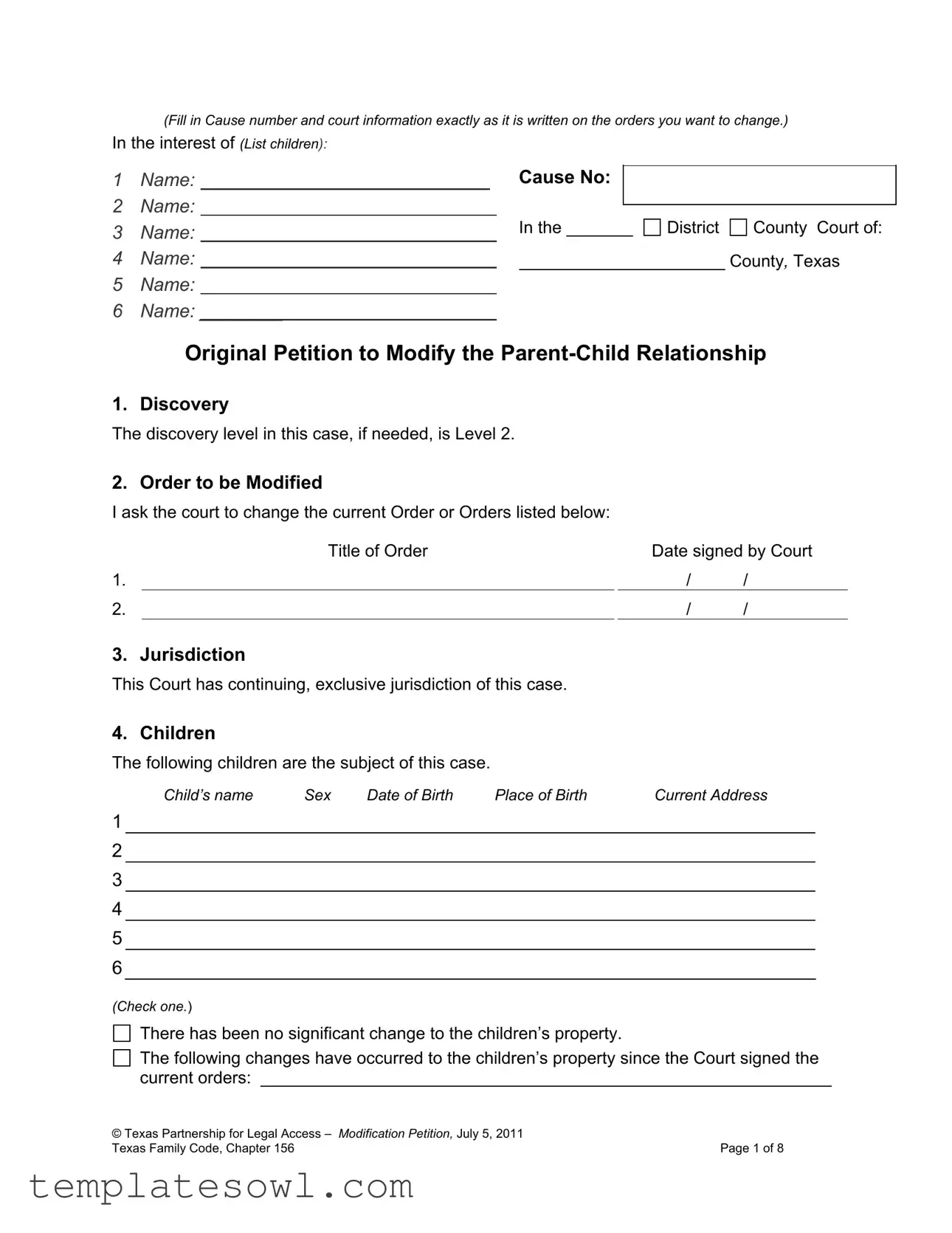I ask the clerk to issue the citation of service. I understand that I will need to pay the fee (or file the form to show the Court that I am unable to pay the fee) and arrange for service.
6. Information Required if a Party Lives Out-of-State
(Check one.)
Everyone involved in this case lives in Texas.
Someone involved in this case (one of the Respondents of me) does not live in Texas. (You must complete and attach Exhibit: Out-of-State Party Affidavit. This is required by Texas Family Code Section 152.209.)
7. Modifications (Changes) Requested
The circumstances of the children, a conservator, or other party affected by the order or orders to be modified have materially and substantially changed since the judge announced the prior order or orders.
The requested modifications are in the best interest of the children.
The requested modifications will change the following parts of the current orders:
7a. Changes to Conservatorship (Custody)
(Check one.)
I do not want to change the conservatorship (custody) orders. (If you choose this box, skip to 7b.)
I ask the Court to change the conservatorship (custody) orders as follows:
I ask the Court to change the conservatorship order to name me: (Check one.)

 Joint Managing Conservator, with the exclusive right to establish the children’s primary residence, (Home-Parent),
Joint Managing Conservator, with the exclusive right to establish the children’s primary residence, (Home-Parent),

 Joint Managing Conservator, noncustodial parent, (Co-Parent)
Joint Managing Conservator, noncustodial parent, (Co-Parent)

 Joint Managing Conservator, with a geographic restriction on where the children’s primary residence will be located and neither parent having the exclusive right to establish the children’s primary residence.
Joint Managing Conservator, with a geographic restriction on where the children’s primary residence will be located and neither parent having the exclusive right to establish the children’s primary residence.

 Sole Managing Conservator, (Home-Parent)
Sole Managing Conservator, (Home-Parent)

 Possessory Conservator, (Co-Parent)
Possessory Conservator, (Co-Parent)
and name Respondent: (Check one for each Respondent, if applicable. Circle the Respondent’s letter. )
AB C  Joint Managing Conservator, with the exclusive right to establish the children’s primary residence, (Home-Parent).
Joint Managing Conservator, with the exclusive right to establish the children’s primary residence, (Home-Parent).
AB C  Joint Managing Conservator, noncustodial parent, (Co-Parent).
Joint Managing Conservator, noncustodial parent, (Co-Parent).
AB C  Joint Managing Conservator, with a geographic restriction on where the children’s primary residence will be located and neither parent having the exclusive right to establish the children’s primary residence.
Joint Managing Conservator, with a geographic restriction on where the children’s primary residence will be located and neither parent having the exclusive right to establish the children’s primary residence.
AB C  Sole Managing Conservator, (Home-Parent).
Sole Managing Conservator, (Home-Parent).
AB C  Possessory Conservator (Co-Parent).
Possessory Conservator (Co-Parent).



 County Court of:
County Court of:

 Do not send a sheriff, constable, or process server to give a copy of this Petition to my spouse, at this time. I think Respondent A will sign a Waiver of Service, or voluntarily file an Answer.
Do not send a sheriff, constable, or process server to give a copy of this Petition to my spouse, at this time. I think Respondent A will sign a Waiver of Service, or voluntarily file an Answer.
 I will have a sheriff, constable, or process server give a copy of this Petition to Respondent A
I will have a sheriff, constable, or process server give a copy of this Petition to Respondent A

 Do not send a sheriff, constable, or process server to give a copy of this Petition to my spouse, at this time. I think Respondent B will sign a Waiver of Service, or voluntarily file an Answer.
Do not send a sheriff, constable, or process server to give a copy of this Petition to my spouse, at this time. I think Respondent B will sign a Waiver of Service, or voluntarily file an Answer.
 I will have a sheriff, constable, or process server give a copy of this Petition to Respondent
I will have a sheriff, constable, or process server give a copy of this Petition to Respondent
 Do not send a sheriff, constable, or process server to give a copy of this Petition to my spouse, at this time. I think Respondent C will sign a Waiver of Service, or voluntarily file an Answer.
Do not send a sheriff, constable, or process server to give a copy of this Petition to my spouse, at this time. I think Respondent C will sign a Waiver of Service, or voluntarily file an Answer.
 I will have a sheriff, constable, or process server give a copy of this Petition to Respondent
I will have a sheriff, constable, or process server give a copy of this Petition to Respondent

 Joint Managing Conservator, with the exclusive right to establish the children’s primary residence,
Joint Managing Conservator, with the exclusive right to establish the children’s primary residence, 
 Joint Managing Conservator, noncustodial parent,
Joint Managing Conservator, noncustodial parent, 
 Joint Managing Conservator, with a geographic restriction on where the children’s primary residence will be located and neither parent having the exclusive right to establish the children’s primary residence.
Joint Managing Conservator, with a geographic restriction on where the children’s primary residence will be located and neither parent having the exclusive right to establish the children’s primary residence.
 Sole Managing Conservator,
Sole Managing Conservator, 
 Possessory Conservator,
Possessory Conservator,  Joint Managing Conservator, with the exclusive right to establish the children’s primary residence,
Joint Managing Conservator, with the exclusive right to establish the children’s primary residence,  Joint Managing Conservator, noncustodial parent,
Joint Managing Conservator, noncustodial parent,  Joint Managing Conservator, with a geographic restriction on where the children’s primary residence will be located and neither parent having the exclusive right to establish the children’s primary residence.
Joint Managing Conservator, with a geographic restriction on where the children’s primary residence will be located and neither parent having the exclusive right to establish the children’s primary residence. Sole Managing Conservator,
Sole Managing Conservator,  Possessory Conservator
Possessory Conservator 

 I ask the Court to place a geographic restriction on where the children’s primary residence can be located.
I ask the Court to place a geographic restriction on where the children’s primary residence can be located.
 I ask the Court to change the geographic restriction on where the children’s primary residence can be located.
I ask the Court to change the geographic restriction on where the children’s primary residence can be located.
 I ask the Court to lift the geographic restriction on where the children’s primary residence can be located.
I ask the Court to lift the geographic restriction on where the children’s primary residence can be located.


 I do
I do 
 I ask the Court to change orders regarding parental rights and duties to the following:
I ask the Court to change orders regarding parental rights and duties to the following:





 Standard visitation, with Petitioner
Standard visitation, with Petitioner 
 Standard visitation, with Respondent A B C
Standard visitation, with Respondent A B C 





 reducing the amount of child support Petitioner pays each month.
reducing the amount of child support Petitioner pays each month.
 increasing the amount of child support Petitioner pays each month.
increasing the amount of child support Petitioner pays each month.
 reducing the amount of child support Respondent A B C pays each month.
reducing the amount of child support Respondent A B C pays each month.
 increasing the amount of child support Respondent A B C pays each month.
increasing the amount of child support Respondent A B C pays each month.





 I will include in the final Order, the social security and driver’s license numbers, current addresses, and phone numbers for each party and child who is subject to this suit, as required by section 105.006 of the Texas Family Code.
I will include in the final Order, the social security and driver’s license numbers, current addresses, and phone numbers for each party and child who is subject to this suit, as required by section 105.006 of the Texas Family Code.
 I ask the Court’s permission not to disclose the social security and driver’s license numbers, current address, and telephone numbers in the Final Order because providing that information is likely to cause the child or a conservator harassment, abuse, serious harm, or injury.
I ask the Court’s permission not to disclose the social security and driver’s license numbers, current address, and telephone numbers in the Final Order because providing that information is likely to cause the child or a conservator harassment, abuse, serious harm, or injury.